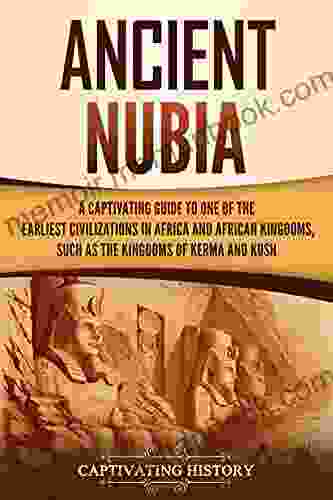The Nile Valley Civilization: A Captivating Guide to One of the Earliest Civilizations in Africa

Nestled along the fertile banks of the Nile River, the Nile Valley Civilization emerged as one of the earliest and most influential civilizations in human history. Its rich legacy, spanning thousands of years, has left an enduring impact on the world, shaping culture, innovation, and the course of civilization.
The Geographical Cradle
The Nile Valley Civilization flourished in the region known as Nubia, which stretches from present-day southern Egypt to northern Sudan. The river's life-giving waters provided sustenance and transportation, allowing for the development of settlements and the rise of complex societies.
The Dawn of Civilization
Around 3500 BCE, the first organized civilizations began to take shape in the Nile Valley. The Badari and Naqada cultures laid the foundation for the later pharaonic era, with advancements in pottery, textiles, and metallurgy.
4.5 out of 5
| Language | : | English |
| File size | : | 13707 KB |
| Text-to-Speech | : | Enabled |
| Screen Reader | : | Supported |
| Enhanced typesetting | : | Enabled |
| Word Wise | : | Enabled |
| Lending | : | Enabled |
| Print length | : | 122 pages |
| X-Ray for textbooks | : | Enabled |
The Predynastic Period
From 3100 to 2686 BCE, the Predynastic Period witnessed the emergence of city-states and the development of writing and irrigation systems. The Hierakonpolis and Nekhen cultures played a pivotal role in unifying the region and laying the foundation for the first pharaonic dynasty.
The Early Dynastic Period
In 3100 BCE, King Narmer united Upper and Lower Egypt, marking the beginning of the Early Dynastic Period. The first pharaohs established a centralized government, built monumental structures, and promoted the arts and sciences. The construction of the Great Pyramid of Giza, one of the world's most iconic landmarks, symbolized the power and ingenuity of this era.
The Old Kingdom
The Old Kingdom (2686-2181 BCE) witnessed the rise of powerful pharaohs such as Djoser and Khufu. The construction of magnificent pyramids, including the Great Pyramid of Giza, reflected their divine status and the architectural prowess of the civilization. Social stratification emerged, with pharaohs at the summit, followed by nobles, priests, and commoners.
The First Intermediate Period
The First Intermediate Period (2181-2055 BCE) marked a period of political instability and fragmentation. However, it also saw the emergence of new innovations, including the development of chariots and the spread of trade. The Herakleopolitan and Theban dynasties vied for power, setting the stage for the Middle Kingdom.
The Middle Kingdom
The Middle Kingdom (2055-1650 BCE) witnessed a resurgence of centralized rule under the pharaohs Mentuhotep II and Amenemhat I. They restored order, expanded the empire, and promoted trade and diplomacy. The construction of the Karnak Temple complex and the establishment of a standing army highlighted the military prowess and organizational abilities of this era.
The Second Intermediate Period
The Second Intermediate Period (1650-1550 BCE) saw the invasion of Egypt by the Hyksos, a foreign group from the Levant. The Hyksos introduced the horse-drawn chariot and composite bow, bringing about new advancements in warfare. After a century of occupation, the Hyksos were expelled by the native Egyptian pharaohs.
The New Kingdom
The New Kingdom (1550-1069 BCE) was a period of unprecedented prosperity and expansion. Pharaohs such as Thutmose III, Hatshepsut, and Ramesses II led successful military campaigns, extending Egyptian influence far beyond its borders. The construction of the Abu Simbel temples, the Valley of the Kings, and the Karnak Temple complex showcased the architectural genius of the New Kingdom.
The Third Intermediate Period
The Third Intermediate Period (1069-664 BCE) saw the decline of pharaonic power and the rise of local rulers. The Libyan and Nubian dynasties ruled over Egypt, leading to the fragmentation of the empire.
The Late Period
The Late Period (664-332 BCE) marked the final era of native Egyptian rule. The Persians invaded Egypt and established their control, introducing new cultural influences. The Greek conquest of Egypt under Alexander the Great in 332 BCE marked the end of the pharaonic civilization.
The Legacy of the Nile Valley Civilization
The Nile Valley Civilization left an enduring legacy on the world. Its advancements in architecture, engineering, and mathematics have inspired generations of builders and thinkers. The concept of monotheism and the belief in an afterlife have had a profound impact on religious thought throughout history. The civilization's contributions to literature, art, and music have enriched human culture and continue to fascinate us today.
Key Cultural and Historical Sites
The Nile Valley Civilization is renowned for its remarkable cultural and historical sites. Some of the most iconic landmarks include:
The Pyramids of Giza: These colossal structures, built as tombs for pharaohs, are among the most famous landmarks in the world.
The Karnak Temple Complex: This vast temple complex, dedicated to the god Amun, is one of the largest and most impressive religious structures ever built.
The Valley of the Kings: This necropolis, located near Luxor, contains the tombs of pharaohs from the New Kingdom.
The Abu Simbel Temples: These two temples, carved into a sandstone cliff, were built by Pharaoh Ramesses II to commemorate his victory in battle.
The Rosetta Stone: This stone tablet, discovered in 1799, played a crucial role in deciphering ancient Egyptian hieroglyphics.
Exploring the Nile Valley Today
The legacy of the Nile Valley Civilization continues to draw visitors from around the world. UNESCO World Heritage Sites, such as the Pyramids of Giza, Abu Simbel, and the Valley of the Kings, offer a glimpse into the grandeur and ingenuity of this ancient civilization. Museums and exhibitions showcase the cultural and historical treasures of the region, providing a deeper understanding of the Nile Valley's rich past.
The Nile Valley Civilization stands as a testament to the human spirit's capacity for innovation, creativity, and organization. Its enduring legacy continues to inspire and fascinate, reminding us of the transformative power of civilization and the importance of preserving our cultural heritage. As we explore the Nile Valley today, we not only witness the remnants of a great civilization but also embark on a journey through the annals of human history itself.
4.5 out of 5
| Language | : | English |
| File size | : | 13707 KB |
| Text-to-Speech | : | Enabled |
| Screen Reader | : | Supported |
| Enhanced typesetting | : | Enabled |
| Word Wise | : | Enabled |
| Lending | : | Enabled |
| Print length | : | 122 pages |
| X-Ray for textbooks | : | Enabled |
Do you want to contribute by writing guest posts on this blog?
Please contact us and send us a resume of previous articles that you have written.
 Top Book
Top Book Novel
Novel Fiction
Fiction Nonfiction
Nonfiction Literature
Literature Paperback
Paperback Hardcover
Hardcover E-book
E-book Audiobook
Audiobook Bestseller
Bestseller Classic
Classic Mystery
Mystery Thriller
Thriller Romance
Romance Fantasy
Fantasy Science Fiction
Science Fiction Biography
Biography Memoir
Memoir Autobiography
Autobiography Poetry
Poetry Drama
Drama Historical Fiction
Historical Fiction Self-help
Self-help Young Adult
Young Adult Childrens Books
Childrens Books Graphic Novel
Graphic Novel Anthology
Anthology Series
Series Encyclopedia
Encyclopedia Reference
Reference Guidebook
Guidebook Textbook
Textbook Workbook
Workbook Journal
Journal Diary
Diary Manuscript
Manuscript Folio
Folio Pulp Fiction
Pulp Fiction Short Stories
Short Stories Fairy Tales
Fairy Tales Fables
Fables Mythology
Mythology Philosophy
Philosophy Religion
Religion Spirituality
Spirituality Essays
Essays Critique
Critique Commentary
Commentary Glossary
Glossary Bibliography
Bibliography Index
Index Table of Contents
Table of Contents Preface
Preface Introduction
Introduction Foreword
Foreword Afterword
Afterword Appendices
Appendices Annotations
Annotations Footnotes
Footnotes Epilogue
Epilogue Prologue
Prologue Duncan Campbell Smith
Duncan Campbell Smith Andrew Lycett
Andrew Lycett Scarlett Parejo
Scarlett Parejo Bryant Terry
Bryant Terry Elvio Cipollone
Elvio Cipollone Arthur L Costa
Arthur L Costa Stone Blue Editors
Stone Blue Editors Andrew Malan Milward
Andrew Malan Milward Linda Davies
Linda Davies Leigh Seddon
Leigh Seddon Liane Holliday Willey
Liane Holliday Willey Gregor Tarjan
Gregor Tarjan Kindle Edition
Kindle Edition Ruth Rendell
Ruth Rendell Kate Fletcher
Kate Fletcher David Wood
David Wood James Lazareth
James Lazareth Peter Cole
Peter Cole Ann Wilmer Lasky
Ann Wilmer Lasky Kevin D Mitnick
Kevin D Mitnick
Light bulbAdvertise smarter! Our strategic ad space ensures maximum exposure. Reserve your spot today!

 Clark CampbellVictorian Poetry On Death And Mourning: Exploring A Literary Response to Loss...
Clark CampbellVictorian Poetry On Death And Mourning: Exploring A Literary Response to Loss... Emmett MitchellFollow ·15.9k
Emmett MitchellFollow ·15.9k Billy PetersonFollow ·8.4k
Billy PetersonFollow ·8.4k Branson CarterFollow ·11.2k
Branson CarterFollow ·11.2k Neil ParkerFollow ·9.7k
Neil ParkerFollow ·9.7k Enrique BlairFollow ·5.1k
Enrique BlairFollow ·5.1k Andres CarterFollow ·4.5k
Andres CarterFollow ·4.5k Pablo NerudaFollow ·18k
Pablo NerudaFollow ·18k Diego BlairFollow ·8.2k
Diego BlairFollow ·8.2k

 Robert Browning
Robert BrowningGeorge Gershwin's "Love You Porgy" from Porgy and Bess: A...
George Gershwin's "Love You Porgy" is an...

 Gary Reed
Gary ReedFitness Exercise Motivation and Goals: Build Lean Muscle...
Embark on a...

 Terence Nelson
Terence NelsonEat More, Train Less, and Get Lean: The Mr. America...
In today's fast-paced world, achieving a...

 J.D. Salinger
J.D. SalingerThe Mystical Poetry of the Wise Magi: Interpreting the...
In the realm of...

 Blake Bell
Blake BellStep By Step Instructions To Maximize Cryptocurrency...
Cryptocurrency...
4.5 out of 5
| Language | : | English |
| File size | : | 13707 KB |
| Text-to-Speech | : | Enabled |
| Screen Reader | : | Supported |
| Enhanced typesetting | : | Enabled |
| Word Wise | : | Enabled |
| Lending | : | Enabled |
| Print length | : | 122 pages |
| X-Ray for textbooks | : | Enabled |












